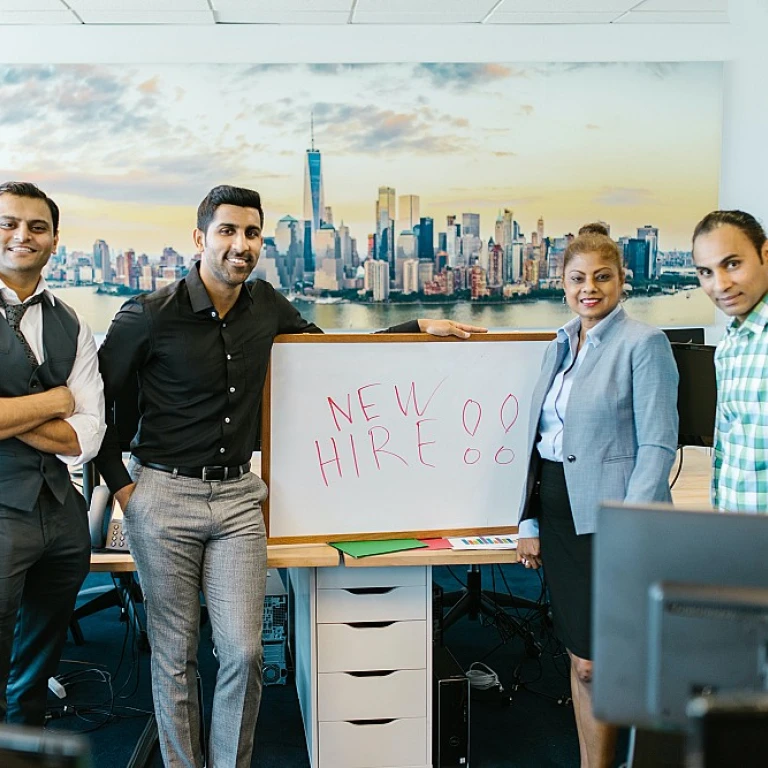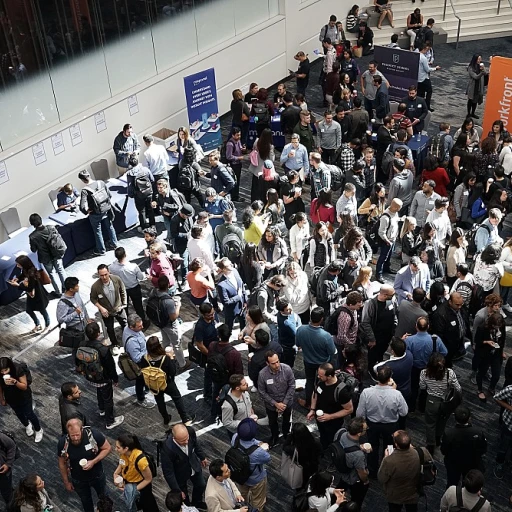Understanding Human Resources Staffing
Fundamentals of Workforce Staffing
Human resources staffing is the backbone of any organization's workforce management. Understanding how to effectively find and hire the right talent is crucial for a company’s growth and success. It involves a comprehensive process where businesses identify current employment needs and actively seek suitable candidates for these positions.
Staffing is not just about filling jobs; it is about strategically placing resources to align with short and long-term business objectives. This requires a deep understanding of various job requirements and the ability to match these with potential employees' skills and career aspirations.
Organizations often rely on a staffing agency or a group of staffing agencies to assist in this complicated process. These agencies have expertise in talent acquisition, offering staffing solutions that range from temp hires to direct hires, making it easier to source group candidates for specialized fields like life sciences or executive positions.
An effective recruitment process requires careful planning and execution. The right mix of professional services and innovative strategies can greatly elevate an organization's ability to find human resources that add value. Firms often implement frontline source measures and employ staffing professionals to aid in managing this critical component effectively.
Would you like to know more about recruitment contracts? You can find a comprehensive guide on enhancing your staffing outcomes with guarantee contracts.
The Role of Technology in Staffing
Technology's Transformative Role in Staffing
As organizations aim to enhance their workforce management, technology is playing a pivotal role in shaping human resources staffing. Advances in technology have streamlined recruitment processes, connecting businesses with the right talent efficiently and effectively. Whether searching for direct hire professionals or temporary contract employees, technology has become a vital tool in the staffing industry.- Automation and Artificial Intelligence: Automation and AI streamline repetitive HR tasks, such as sorting resumes or pre-screening candidates, allowing human resource teams to focus on making more informed decisions. AI-driven algorithms can sift through vast amounts of data to find top candidates, enhancing the recruitment process.
- Data-Driven Decision Making: Access to real-time data analytics has revolutionized how staffing agencies work. Organizations can now track recruitment processes, measure candidate engagement, and predict hiring needs, thus making strategic staffing decisions.
- Applicant Tracking Systems: These systems have become a staple for sourcing and managing candidates throughout the recruitment process. They help human resource teams to keep track of job applicants, ensuring a smoother hiring process.
- Online Job Platforms: Online platforms have opened new avenues for discovering talent across various industries, including life sciences and executive search. These platforms help organizations to find qualified candidates globally, supporting both full-time and temporary hires.
Challenges in Human Resources Staffing
Technology's Impact on Overcoming Challenges
In the ever-evolving business landscape, organizations face multiple challenges in human resources staffing. These challenges range from locating top talent to effectively managing the diverse HR processes inherent in today’s complex work environments. Fortunately, technology plays a pivotal role in mitigating these difficulties, streamlining operations, and enhancing efficiency. One major challenge in staffing is the daunting task of finding suitable candidates in a vast pool of potential hires. Human resource professionals often find themselves burdened with the manual processes of reviewing resumes and conducting screenings. However, leveraging technology, such as recruitment automation tools, can significantly ease and accelerate these tasks, optimizing the recruitment process and allowing HR teams to focus on strategic initiatives. Staffing agencies and companies alike encounter the obstacle of matching the right talent with the right job. AI-driven platforms can help identify promising candidates by analyzing pertinent data points, ensuring a high match rate. This not only aids in the recruitment process but also boosts the overall quality of hires, fostering long-term engagement. Moreover, maintaining clear communication within an organization is crucial. Human resources information systems (HRIS) can facilitate seamless communication across various departments and improve the employee experience by providing self-service options for employees. Valuable feedback loops are essential, and enhancing employee feedback with HRIS is a step toward better resource management. Another persistent challenge is retaining high-performing employees. Predictive analytics within HRIS can help identify at-risk employees and provide insights into designing effective retention strategies. By integrating technology effectively, companies can transform these traditional staffing hurdles into opportunities for growth and development, setting the stage for organizational success.Innovative Staffing Strategies
Embracing Modern Staffing Approaches
In today's fast-paced business environment, organizations are constantly seeking innovative staffing strategies to effectively manage their workforce. The traditional methods of recruitment and hiring are being supplemented, if not replaced, by more dynamic approaches that better align with the evolving needs of businesses and the available talent pool.
One such strategy is leveraging staffing agencies and staffing solutions that specialize in specific industries or job types. These agencies not only help find the right candidates but also offer a wealth of expertise in navigating the complex landscape of human resources staffing. By partnering with a specialized staffing agency, companies can tap into a broader network of potential hires, including those who may not be actively seeking new opportunities but are open to the right offer.
Leveraging Technology for Better Outcomes
Technology plays a crucial role in innovative staffing strategies. Tools that facilitate talent acquisition and streamline the recruitment process are invaluable. For instance, AI-driven platforms can help identify and match candidates to job openings more efficiently than traditional methods. These platforms can analyze vast amounts of data to predict candidate success, ultimately reducing the time and cost associated with hiring.
Additionally, the use of executive search firms and platforms that focus on direct hire solutions can be a game-changer for organizations looking to fill full-time positions with top-tier talent. Such approaches not only expedite the recruitment process but also ensure that the candidates are a good fit for the company's culture and long-term goals.
Building a Flexible Workforce
Another innovative strategy is the adoption of a more flexible workforce model. This involves a mix of temp hire and long-term employees, allowing businesses to adapt quickly to changing demands. Temporary hires can provide immediate support for short-term projects, while permanent staff ensure continuity and stability.
Moreover, organizations are increasingly looking at alternative talent pools, such as life sciences professionals, to fill specialized roles. By broadening the scope of their recruitment efforts, companies can find human resources that bring diverse skills and perspectives to the table, enhancing creativity and problem-solving capabilities within teams.
In conclusion, the key to successful staffing lies in the ability to adapt and innovate. By embracing modern strategies and technologies, businesses can not only meet their current staffing needs but also position themselves for future success.
Measuring Staffing Success
Effectively Evaluating Staffing Success
Measuring the success of human resources staffing initiatives is important for ensuring that an organization is meeting its workforce needs efficiently and effectively. Staffing metrics provide valuable insights into how well your organization is doing at attracting and retaining the right talent.- Quality of Hire: This metric assesses the performance and satisfaction of employees post-hiring. Organizations often measure this by evaluating new hire turnovers, performance ratings, and the alignment of employees with job roles.
- Time to Fill: It is crucial to consider how efficiently your organization can fill open positions. This metric helps in analyzing how long it takes to move a candidate through the hiring process and can indicate bottlenecks within your recruitment process.
- Hiring Manager Satisfaction: This metric evaluates the satisfaction of those directly responsible for hiring decisions. Surveying hiring managers post-hire can provide insights into the efficiency of the staffing process and the fit of new hires.
- Candidate Experience: A positive experience for candidates during the recruitment process can enhance your employer brand and attract higher quality talent. Feedback through surveys or focus groups can be instrumental.
- Turnover Rates: High turnover can be indicative of issues in the staffing process or poor alignment between employee expectations and job realities. Analyzing these rates helps pinpoint areas for improvement.
Future Trends in Human Resources Staffing
Emerging Trends in Effective Talent Sourcing
The rapidly evolving landscape of human resources staffing is constantly introducing new methodologies and technologies. Organizations are actively seeking innovative ways to streamline recruitment processes and enhance their workforce management capabilities. Here are some of the emerging trends that businesses should consider when aiming to optimize their staffing strategies.
- AI-Powered Recruitment Tools: Artificial intelligence is significantly transforming how companies find and hire talent. AI-driven platforms help human resources teams efficiently sift through resumes, source candidates, and identify top professionals suited for specific roles. By leveraging machine learning algorithms, staffing agencies can enhance job matching accuracy and speed.
- Emphasis on Employer Branding: Businesses are increasingly recognizing the importance of employer branding in attracting the right talent. Through well-defined company culture and value propositions, organizations can position themselves as employers of choice. This helps in attracting both direct hire and temp hire candidates who fit well with the company's ethos.
- Remote Work and Gig Economy: The rise of remote work and the gig economy continues to revolutionize human resources staffing. Organizations are more inclined towards virtual collaboration, which extends their talent pool globally. This shift allows staffing solutions to accommodate flexible and project-based hiring needs.
- Diversity and Inclusion Initiatives: Companies are prioritizing diversity in their talent acquisition strategies. By implementing inclusive hiring practices, businesses aim to create a workplace that thrives on varied perspectives and backgrounds. This effort not only enhances company culture but also boosts employee performance.
- Data-Driven Recruitment Decisions: The use of data analytics is becoming crucial in the recruitment process. Human resources professionals are using data insights to refine recruitment strategies and enhance resource allocation. This data-centric approach helps in making informed recruitment decisions and measuring staffing success more effectively.
Organizations should keep abreast of these trends to ensure their staffing strategies remain competitive and relevant. By incorporating innovative technologies and approaches, companies can improve their recruitment processes and secure the best talent in the market.






